Fire breathing
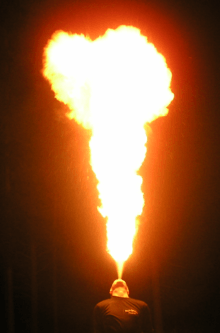
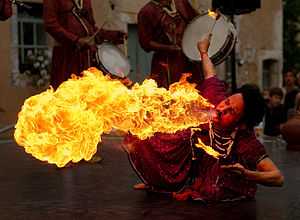
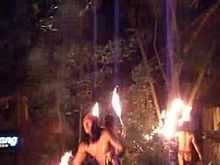
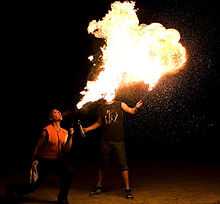
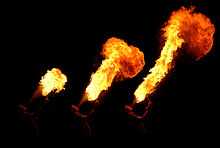
Fire breathing is the act of creating a plume of fire by breathing a stream of fuel over an open flame. It can be a dangerous activity but the proper technique and the correct fuel reduces the risk of injury.
Performance
Fire breathing is performed by both professionals and non-professionals. Professional fire breathers usually incorporate the fire performance skill within a show where other fire skills are performed. The element of danger in performing fire breathing and other fire skills enhances the entertainment spectacle for many audience members.
Training
The vast majority of professional fire-breathers are apprenticed by a seasoned professional and it is strongly recommended that teaching oneself be avoided due to the extreme risks. Most people who are taught fire breathing and eating skills are seasoned performers in their own right and are taught under the condition that the skills are not passed on until they become a recognised fire performer. Virtually all recorded incidents of serious injury by fire breathing involve untrained individuals, often while under the influence of alcohol. Using an incorrect fuel is usually a strong contributing factor.
Health and safety
Performing with fire has many inherent risks to the health and safety of the practitioners. Fire breathing has a wider range of risks due to the required technique to create the effect. Having an actively spotting trained safety assistant with an appropriate fire blanket and fire extinguisher is an appropriate best practice when fire breathing and is a mandatory clause in most insurance policies for professional fire breathers.[1][2]
Fuels
To increase safety, fire breathers must avoid highly combustible fuels such as alcohol, spirit-based fuels, and most petrochemicals, instead using safer combustibles with a higher flash point (>50 °C). Due to its relatively safe (~90 °C) flash point, paraffin, or highly purified lamp oil, is the preferred fuel for fire breathing. Although corn starch has been cited as a non-toxic fuel, the hazards of inhalation increase the potential risk of lung infections.
Fuels that are considered especially dangerous include:
- Ethanol can be absorbed into the blood stream without drinking. Thus attempting fire breathing with ethanol can cause intoxication.
- Methanol (used with many colored flame recipes) has a variety of entry vectors and can cause blindness or neurological disorders.
- Very low flash point fuels like naphtha, butane, and propane can create a condensed vapor build-up in the oral cavity leading to internal combustion, damaging the mouth or lungs. Naphtha also is quite carcinogenic, and performance careers built on using it entail a high risk of mouth cancer.
- Common fuels like gasoline and kerosene often contain carcinogenic additives or refining by-products, such as sulfurated compounds, or benzenes. They also are far easier to ignite and even a seasoned fire breather would be at serious risk of injury using these fuels for breathing
Self-ignition
There is a risk of self ignition while performing fire breathing. Enhanced risk comes from the use of lower flash point fuels, inapproprite fabrics in clothing (such as polyester), wearing other flammable items or products (such as hairspray), poor technique and performance in unsuitable locations.
There are currently major calls from within the fire performance industry itself for regulation as a large number of self-taught fire performers have appeared on the scene (particularly in the UK) who have insufficient training and are posing extreme risks.
Health
When fire breathing with the wrong fuel, or when an improper technique is used, fire breathing can increase the risk of:
- Death
- Severe burns
- Fire breather's pneumonia, a distinct type of lipid pneumonia[3]
- Acute respiratory distress
- Dental problems
- Fuel poisoning
- Dry cough
- Headache, dizziness, drunken ill feeling
- Nausea, diarrhea, vomiting, stomach ache
- Dry mouth/cotton mouth
- Dry skin and topical heat burns
- Cancer of the mouth or throat from petrochemical exposure
In modern culture
Gene Simmons
Rock and Roll bassist Gene Simmons breathes fire as a part of his onstage persona as "The Demon" in the band KISS. Simmons is probably one of the most well known firebreathers as he has been doing it during KISS concerts for over 40 years. Gene learned to breathe fire from a magician known by the name of "Amaze-O".
Black metal
The heavy metal subgenre known as black metal has been known to feature fire breathing among its imagery. While heavy metal has a history of including fearsome stunts and sideshow spectacles, A suggested originator of fire breathing in black metal culture was Quorthon, frontman of the Swedish black metal band Bathory. In a number of promotional photos, all dating from before 1988, Quorthon is seen breathing fire. Quorthon ceased this spectacle due to overblown media attention to his image rather than music.[4]
As the Scandinavian black metal scene of the 1990s expanded, a number of Norwegian musicians began to produce similar promotional photos of fire breathing. A number of black metal music videos have featured examples of fire breathing as well, including Immortal's "Call of the Wintermoon" and Satyricon's "Mother North".
In other bands
Fire breathing has been utilized in many bands of varying genres as an eye-catching spectacle. The MC Bat Commander, lead singer of the California comedy rock/New Wave/ska band The Aquabats, would regularly breathe fire to start off the band's shows during the late 1990s and early 2000s.[5] Mike Odd, the vocalist for the shock rock/horror metal band Rosemary's Billygoat, included fire breathing in the band's many outlandish stunts, alongside other forms of small-scale pyrotechnics.[6]
In fiction
- Dietrich von Bern, a figure from medieval German heroic poetry breathes fire, illustrated in illuminated manuscripts (See #Rose Gardensection)
- The title character of the 1987 Data East arcade game Karnov is a fire-breathing strongman.
- The title character of Xena: Warrior Princess (1995-2001) is capable of breathing flame at her opponents using a mouthful of alcohol and a nearby source of fire.
- In the Pokémon game series, Firebreathers are a common trainer class.
- In the anime and manga Inuyasha (1996-2008), Renkotsu of The Band of Seven uses oil to breathe fire.
- In the sci-fi horror film Pitch Black (2000), the character Paris breathes fire using his flask and lighter
- David Almond's book The Fire-Eaters (2003) is the story of a young boy living in Northumberland who gets to know a local performing fire eater.
- In Cornelia Funke's novel Inkheart (2003), the character Dustfinger is a talented fire-eater and fire-breather.
- In the Mario video game franchise published by Nintendo, Bowser is best known for breathing fire along with the Koopalings, Reznors and Bowser Jr.
- In Skins series 3, episode 5 (2009), JJ performs fire-breathing stunt, by swallowing a spliff and feigning choking, before taking a swig from a bottle that supposedly contained urine, and blew a fireball with a lighter. The urine was, in fact, paraffin that JJ had placed there eight months previously in preparation of the illusion. According to the DVD extra, JJ's actor, Ollie Barbieri, actually performed the stunt, and the startled reactions from co-actors Luke Pasqualino, Jack O'Connell and Kaya Scodelario were genuine.
- In Jackie Chan Adventures, the holder(s) of the Dragon Talisman can breathe fire. Shendu is shown to breathe fire with and without his Dragon Talisman. His son Drago can do so with the fire demon chi built within him. Drago also can give part of his chi to anyone he wishes, in this case his henchman StrikeMaster Ice was given the opportunity to breathe fire and hold it in his hands like his boss
- Iroh, of Avatar: the Last Airbender, was known as "The Dragon of the West" for his ability to use a rare, but not unique, firebending technique to breathe fire.
World records
Simultaneous fire breathing
The world record for the number of people simultaneously fire breathing was set on 23 April 2009 by 293 students in the Dutch city of Maastricht as part of the Ragweek charity event.[7]
Fire breathing pass
In August 2007 the record for the biggest fire breathing pass was set at the Burning Man festival in the Black Rock Desert, Nevada; a single breath was passed to 21 people before the flame went out.[8]
Highest flame
The world record for the highest flame is 8.05 m (26 ft 5 in), set by Antonio Restivo at a warehouse in Las Vegas, Nevada, USA, on 11 January 2011.[9]
Most flames
The most consecutive fire flames blown by one mouthful of fuel (without refuelling) is 182, achieved by Tobias Buschick (Germany) in Neuenbürg, Germany, on 3 August 2013.[10]
The most flames blown in one minute is 189 (with refuelling) and was achieved by Zhu Jiangao (China) on the set of CCTV - Guinness World Records Special in Jiangyin, Jiangsu, China on 9 January 2015.[11]
See also
- Fire eating
- Fire dancing
- Fart lighting
References
- ↑ Pele "Fire Breathing", 2002. Retrieved on 2010-10-18.
- ↑ NAFAA "NAFAA Performer Safety Guidelines. (Revision 2.1)", 2010-7-5. Retrieved on 2010-10-18.
- ↑ I. Weinberg and Z. G. Fridlender "Exogenous lipoid pneumonia caused by paraffin in an amateur fire breather -- Weinburg and Fridlender 60 (3): 234", Occupational Medicine, 2010-3-22. Retrieved on 2010-8-22.
- ↑ "Names Rumors Legends Music and Image". Bathory.nu. 2003-01-01. Retrieved 2012-12-08.
- ↑ "Aquabats and Mealticket to return for Ska Patrick's Day fest in Provo". Deseret News. 14 March 1997.
- ↑ Distefano, Alex (21 November 2013). "Top 10 Shock Rock Bands of All Time". OC Weekly.
- ↑ "Most people fire breathing". guinnessworldrecords.com. Retrieved 7 April 2011.
- ↑ "Fire breathing". Webster's online dictionary. Retrieved 7 April 2011.
- ↑ "Highest flame blown by a fire breather". guinnessworldrecords.com. Retrieved 7 April 2011.
- ↑ http://www.guinnessworldrecords.com/world-records/most-consecutive-fire-flames-blown-by-mouth-(without-re-fuelling)/
- ↑ http://www.guinnessworldrecords.com/world-records/fire-breathing-most-flames-blown-in-one-minute/
External links
| Wikimedia Commons has media related to Fire breathing. |
- North American Fire Arts Association
- Fire Breathing and Fire Eating FAQ by Juggling Information Service, 1996, retrieved 25 September 2006